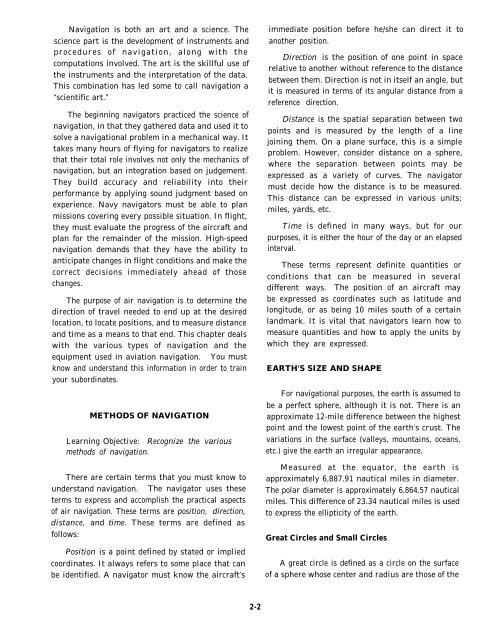Aviation Electronics Technician 1 - Historic Naval Ships Association
Aviation Electronics Technician 1 - Historic Naval Ships Association
Aviation Electronics Technician 1 - Historic Naval Ships Association
Create successful ePaper yourself
Turn your PDF publications into a flip-book with our unique Google optimized e-Paper software.
Navigation is both an art and a science. Thescience part is the development of instruments andprocedures of navigation, along with thecomputations involved. The art is the skillful use ofthe instruments and the interpretation of the data.This combination has led some to call navigation a“scientific art.”The beginning navigators practiced the science ofnavigation, in that they gathered data and used it tosolve a navigational problem in a mechanical way. Ittakes many hours of flying for navigators to realizethat their total role involves not only the mechanics ofnavigation, but an integration based on judgement.They build accuracy and reliability into theirperformance by applying sound judgment based onexperience. Navy navigators must be able to planmissions covering every possible situation. In flight,they must evaluate the progress of the aircraft andplan for the remainder of the mission. High-speednavigation demands that they have the ability toanticipate changes in flight conditions and make thecorrect decisions immediately ahead of thosechanges.The purpose of air navigation is to determine thedirection of travel needed to end up at the desiredlocation, to locate positions, and to measure distanceand time as a means to that end. This chapter dealswith the various types of navigation and theequipment used in aviation navigation. You mustknow and understand this information in order to trainyour subordinates.METHODS OF NAVIGATIONLearning Objective: Recognize the variousmethods of navigation.There are certain terms that you must know tounderstand navigation. The navigator uses theseterms to express and accomplish the practical aspectsof air navigation. These terms are position, direction,distance, and time. These terms are defined asfollows:Position is a point defined by stated or impliedcoordinates. It always refers to some place that canbe identified. A navigator must know the aircraft’simmediate position before he/she can direct it toanother position.Direction is the position of one point in spacerelative to another without reference to the distancebetween them. Direction is not in itself an angle, butit is measured in terms of its angular distance from areference direction.Distance is the spatial separation between twopoints and is measured by the length of a linejoining them. On a plane surface, this is a simpleproblem. However, consider distance on a sphere,where the separation between points may beexpressed as a variety of curves. The navigatormust decide how the distance is to be measured.This distance can be expressed in various units;miles, yards, etc.Time is defined in many ways, but for ourpurposes, it is either the hour of the day or an elapsedinterval.These terms represent definite quantities orconditions that can be measured in severaldifferent ways. The position of an aircraft maybe expressed as coordinates such as latitude andlongitude, or as being 10 miles south of a certainlandmark. It is vital that navigators learn how tomeasure quantities and how to apply the units bywhich they are expressed.EARTH’S SIZE AND SHAPEFor navigational purposes, the earth is assumed tobe a perfect sphere, although it is not. There is anapproximate 12-mile difference between the highestpoint and the lowest point of the earth’s crust. Thevariations in the surface (valleys, mountains, oceans,etc.) give the earth an irregular appearance.Measured at the equator, the earth isapproximately 6,887.91 nautical miles in diameter.The polar diameter is approximately 6,864.57 nauticalmiles. This difference of 23.34 nautical miles is usedto express the ellipticity of the earth.Great Circles and Small CirclesA great circle is defined as a circle on the surfaceof a sphere whose center and radius are those of the2-2
















